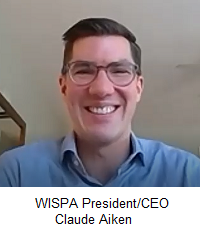Members of the Wireless Internet Service Providers Association (WISPA) are looking forward to getting a chance to apply for broadband funding from the Infrastructure Act. Some WISPs are looking to expand or upgrade their networks, notes WISPA President/CEO Claude Aiken. He told Inside Towers the association has been working to get members “a fair shot at accessing” that capital.
Another goal for this year is making sure that companies that don’t want the funding, either because “there are a lot of strings attached or they don’t have the matching funds” or other reasons, “to ensure that they’re also treated fairly. To the extent that they are providing quality, speedy broadband, that they’re not subject to government subsidized overbuilding,” he said during an interview. He summed up the twin goals of making a space for companies that do want to take advantage of the funding, and to ensure that those who don’t aren’t subject to what he calls “unfair competition.”
WISPA also cares about preserving flexibility for communities and providers to pick the right tools for broadband deployment. “There are places where it absolutely makes sense for fiber, [and] there are places where it absolutely makes sense for wireless. But when you are unduly prescriptive, that’s when outcomes in the marketplace tend to be less than optimal,” said Aiken.
He cites an example of funding a fiber network that is unsustainable in the long term, or funding a network that can’t keep up with demand. The goal is to ensure there’s a partnership between states, and communities and ISPs to “be able to figure out what the right solution is.”
Historically, WISPA has been a home for WISPs, however, many of its members are diversifying. “Our members aren’t necessarily just the small, rural wireless ISP anymore. It’s companies that have been either fiber or cable ISPs who are starting to add fixed wireless and some of our legacy wireless members are starting to deploy fiber,” explains Aikens. He also cited a new phenomenon of urban WISPs starting to stand up and gain market share in highly competitive environments.
Asked when NTIA could be ready to accept applications for funds from states, Aiken predicted early next year. NTIA needs to have its initial funding rules out in May, but the Infrastructure Act requires NTIA to use the FCC’s new broadband coverage maps as the basis for distributing funding. He said a lot of moving pieces are involved and it’s going to take time to put everything together.
Similar to other telecom sector companies, WISPs are impacted by the workforce shortage. “We’re looking to connect every American to high-speed connectivity. But that also means you have to have the folks who are going to operate the directional drills, the folks who are going to be installing the fixed wireless” gear in households and businesses, explains the WISPA executive.
Supply chain issues factor into deployment, too. “If the goal is really to connect all Americans with the pot of money that we have, and to do so relatively quickly, we’ve got to be flexible in the types of technologies and the types of entities that are able to access that funding,” notes Aiken.
Aiken came to WISPA in 2018, after nearly a decade at the FCC, where he was an advisor to Chairman Tom Wheeler and Commissioner Mignon Clyburn. He held senior leadership positions in the Wireline Bureau and Office of General Counsel, as well staff attorney roles throughout the Commission.
Last week, Aiken announced he intends to leave the organization at the end of April, Inside Towers reported. He said it’s been “gratifying and humbling, after making that announcement, to getting outreach from everyone from members of Congress to CEOs of our member companies, just saying how far they’ve seen WISPA come over the past few years.” He credits the work of WISPA’s staff and its member companies for the organization’s growth in membership and heightened profile among lawmakers and regulators.
By Leslie Stimson, Inside Towers Washington Bureau Chief





Reader Interactions